Contrary to popular belief, it was not the Europeans who hunted black slaves in Africa. They were just driving the demand. Africans were captured and sold ... by their neighbors and brothers. When a fabulous fortune loomed on the horizon, no one cared about human dignity.
Sir John Hawkins had many advantages. For example, he developed a completely new model of a warship that not only improved navigation and gave the British navy an advantage in the seas and oceans, but also completely changed the strategy of naval warfare. He was also an outstanding navigator who, among other things, marked a circular trade route across the Atlantic, as well as an efficient agent of the British Crown. All these qualities earned him the rank of admiral and considerable influence at court.
However, his fortune came from a completely different talent, revealed in the early 1660s. Like no one else, namely , he was able to provoke tribal wars in Africa. He later accepted the slaves captured during them as payment for his agency and cooperation.
If, during his first African expedition in 1562, he did not shy away from the use of force and captured three hundred slaves - as he wrote - c partly with a sword and partly by other means . four years later, the sword was out of the question.
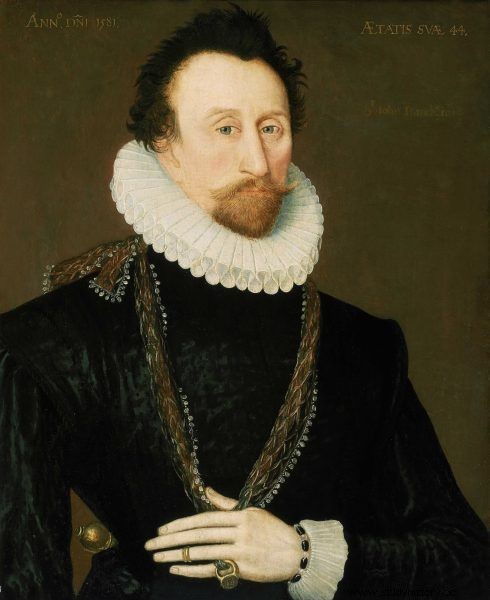
Sir John Hawking was a man of many talents. But he did one thing remarkably - namely provoking conflicts between African tribes (source:public domain).
On the Sierra Leonese coast, inciting some African rulers against another, he stocked up almost twice as much "black stuff", to the glory of England and his own purse. It was this method of obtaining free labor for America's plantations that became the most common by the end of the 19th century
Monopoly on "black goods"
Slavery was nothing special in Africa. As in all other parts of the world, people could be captured as a result of a lost war, debt, or some serious crime. But it was not slavery in the sense that US growers would later give it - it resembled the serfdom of the peasants in feudal Europe rather than chains and a whip in Arizona's cotton fields .
The practice of trafficking of black slaves with Arab and European countries was not a peculiarity either. As for the latter, it began in the 15th century, and its initiators and monopolists for almost a century were the Portuguese.
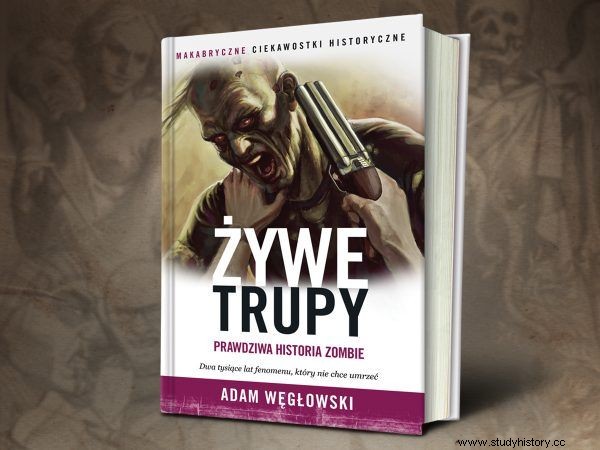
Like Hawkins later, they also started with force, kidnapping people from the Gold Coast in the Gulf of Guinea, at the height of modern Ghana and the Slave Coast (today Nigeria, Benin and Togo) by a pirate method.
However, exploration into the interior of the continent was prevented by relatively strong countries in this region, such as the then experiencing their greatest boom, the Songhaj kingdoms, Mali and the very strongly developed Congo. The rulers of these countries did not mind the mere kidnapping of members of the smaller tribes, but the fact that they did not gain anything from it.
Their armed resistance and the commercial sense of the Portuguese very quickly led to the creation of an efficiently functioning market for trade in human beings, in which the role of suppliers was played by the countries of the Black Continent , specialized and armed trading companies of dark-skinned merchants, as well as smaller groups of quick-profit hunters.
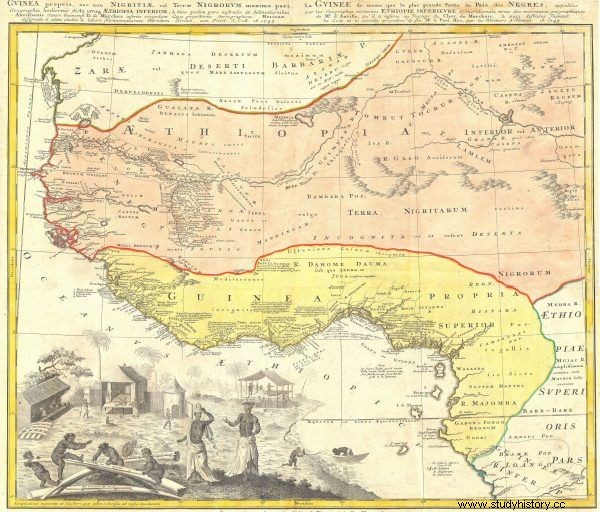
The 18th-century map of Homann Heirs shows the Bay of Slaves - the coast of West Africa. It was from here that the main trafficking routes for human beings ran, first to Portugal, then to America (source:public domain).
The proportions look interesting. We don't have data for that period, but in the 18th century - when the audience changed but the mechanics of the market itself remained the same - of the six hundred slaves delivered to the Slave Coast, only ten percent were officially provided by the state, twenty percent by smaller hunters, and the remaining seventy percent by larger organizations. merchant.
It follows that for several centuries on the west coast of Africa, officially existed organizations that dealt solely with the capture and sale of local people into slavery . Besides, the word "coast" does not fully reflect the scale of penetration of the African interior. If in the vicinity of Senegal in the 17th century the average distance that slaves had to travel to the European ships waiting for the seas was one hundred kilometers, then a century later - already six hundred.
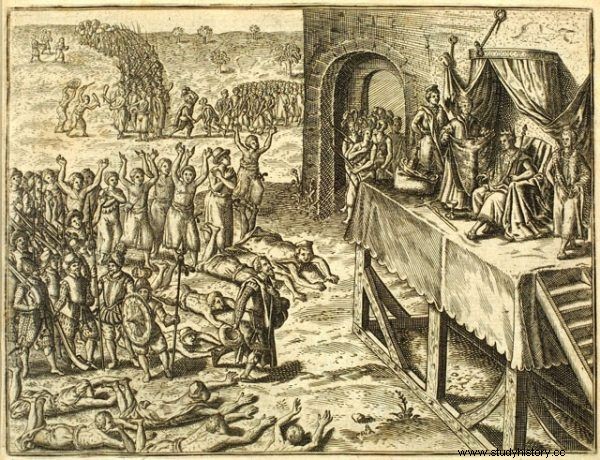
Who benefited from the slave trade? Suppliers - the largest and strongest states of the Black Continent of that time! The illustration shows an audience of a delegation from Portugal with the ruler of the Kingdom of Congo (source:public domain).
Of course, they could not function without the consent of the rulers, which the Europeans were well aware of. Perhaps the most Europeanized monarchy there, Congo, has entered into an official alliance with Portugal . The ruling mani there - as his official title sounded - Nzinga even got baptized and continued to reign under the name of Alfonso.
A bishopric was established in the state, and the sons of the local elite were sent to Portugal where they received education, and after returning to the country, they served as intermediaries, guides and translators. The new state on the map of the Christian world did not forget about its benefactors. At the port of Kabinda in the mouth of the Zaire River, in the 1620s, two thousand slaves a year were waiting for them in the 1620s. and a decade later twice as many.
For beads and weapons
One African was believed to be worth four Indians - Adam Węgłowski writes in his book "The Living Dead". - Moreover, the use of already Christianized Indian tribes was opposed by the influence of the then Jesuits. Black Africans,> pagans <(animists, Muslims, etc.) bought from slave traders, could not count on similar considerations .

Slavery in Africa had a long tradition even before the unfortunates of Africa began to find their way into American cotton plantations (source:public domain).
The profitability of trade with the local population with Europeans was the reason for a kind of race for a monopoly in this matter. The peoples of Hueda, Allada, Oyo, Dahomey and Akwam were particularly active. When the latter in 1681 seized the important port of Accra, merchants were officially banned from staying in the interior of the country in order to prevent them from hunting slaves and to ensure the exclusivity of the state in this respect .
The rulers of Dahomey did exactly the same, establishing a monopoly on their property , they sold twelve to twenty thousand slaves a year. A bit more to the east of the continent - within the Arab influences, which did not differ in any way from the European ones - in this practice one can find the roots of the bloody and lasting to this day conflict between the Hutu and Tutsi tribes .
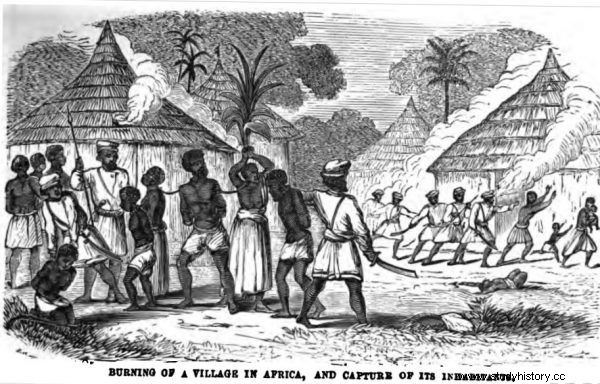
As serious profits and serious competition began to come into play, slave hunts became more and more brutal (source:public domain).
The slave hunt has become more and more brutal over the years and the political destabilization of the continent was reaching the limits of anarchy. Obviously, this was very useful to the European powers, which fueled this process, increasing the demand for "live goods" from year to year. But not only. Henry Zins wrote:
In the slave trade between African intermediaries and European buyers, iron bars were used as a form of money from Senegal to Côte d'Ivoire. In the vicinity of Ghana, their role was played by:golden sand, bracelets, Indian cloth, shells and beads.
In fact, however, as the business grew, was increasingly paid for guns and gunpowder which over time brutalized the hitherto primitive military tactics of African states. A lot has changed also on the European side.
Until the end of the 16th century, Portugal was the monopolist in the trade of African slaves - selling them to America, but also willingly using them on their own estates. It was there, specifically in Madeira, where the experiment with a slave labor plantation system was first used which was widely used later in the US.
However, at the beginning of the 17th century, the Netherlands joins the slave trade and quickly gains an advantage, and Amsterdam becomes the largest "transhipment" port for captured Africans. This situation lasts more or less until the middle of the century, when the huge profitability of this business tempts other European countries - not only England and France, which have been constantly fighting for the first place on the podium, but also Sweden, Denmark and even Brandenburg.
The scale of the phenomenon is so serious that both in France and England special African Companies are established, which are granted a monopoly on the trade in black slaves , and the crowned heads of these countries and a large part of the aristocracy have a share in them. The piquancy is added by the fact that a share in the Royal African Company was also held by the philosopher John Locke - a great eulogist of freedom.
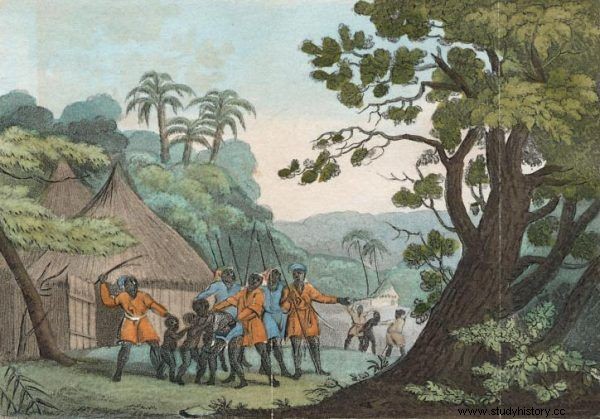
The profitability of the slave trade has tempted most European countries to profit from the deal. But catching the unfortunates was the task of their kin (source:public domain).
It is not really known how many Africans were taken captive. Extreme estimates are between ten and a hundred million , the latter number seems to be an exaggeration, however. The continent was so catastrophic that all participating states formally abolished slavery at the Congress of Vienna in 1815.
Of course, one should not sniff the exaggerated humanitarianism of the European elite here - that's when the era of African colonialism began, why would you like depopulated colonies? Besides the formal acts, the business was too good to be cut off with one document.
In practice, black slaves were traded several dozen years later, until the end of the 19th century. Only the supplier has changed - it was no longer African countries, as for four hundred years, but the greatest powers in Europe. Although they undoubtedly benefited from the help of local "businessmen".
***
The blood and sweat of slaves, their magical beliefs and dark rituals, the cruel practice of trafficking in human beings - this is where Adam Węgłowski searches for the roots of the zombie phenomenon, which has completely mastered contemporary pop culture. The book “The Living Dead. A real zombie story ", published by Historical Trivia, you can buy as much as 30% cheaper!
